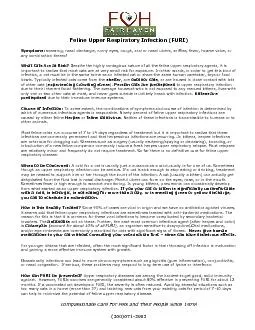

Symptoms sneezing nasal discharge runny eyes cough oral or nasal ulcers sniffles fever hoarse voice or any combination thereof What Cats Are at Risk Despite the highly contagious nature o ID: 837564
Download Pdf The PPT/PDF document "Feline Upper Respiratory Infection FURI" is the property of its rightful owner. Permission is granted to download and print the materials on this web site for personal, non-commercial use only, and to display it on your personal computer provided you do not modify the materials and that you retain all copyright notices contained in the materials. By downloading content from our website, you accept the terms of this agreement.
1 Feline Upper Respiratory Infection (FURI
Feline Upper Respiratory Infection (FURI) Symptoms: sneezing, nasal discharge, runny eyes, cough, oral or nasal ulcers, sniffles, fever, hoarse voice, or any combination thereof What Cats Are at Risk? Despite the highly contagious nature of all the feline upper respiratory agents, it is important to realize that most cats are at very small risk for exposure. In other words, in order to get this kind of infect ion, a cat must be in the same home as an infected cat or share the same human caretaker, toys or food bowls. Typically infected cats come from the shelter , are outdoor cats , or are housed in close contact with lots of other cats ( experiencing crowding str ess ). Persian cats are predisposed to upper respiratory infection due to their inherent facial flattening. The average housecat who is not exposed to any rescued kittens, lives with only one or two other cats at most, and never goes outside is unlikely bre ak with infection. Kittens are predisposed due to their immature immune systems. Course of Infection: To some extent, the combinations of symptoms and course of infection is determined by which of numerous infectious agents is responsible. Ninety percent of feline upper respiratory infections are caused by either feline Herpes or feline calicivirus . Neither of these infections is transmissible to humans or to other animals. Most feline colds run a course of 7 to 14 days regardless of treatment but it is i mportant to realize that these infections are commonly permanent and that herpesvirus infections are recurring. In kittens, herpes infections are notorious for dragging out. Stresses such as surgery (usually neutering/spaying or declawing), boarding, or in troduction of a new feline companion commonly induce a fresh herpes upper respiratory relapse. Most relapses are relatively minor and frequently do not require treatment. So far there is no definitive cure for feline upper respiratory disease. When to be C oncerned: A cold for a cat is usually just a nuisance as a cold usually is for one of us. Sometimes though an upper respiratory infection can be serious. If a cat is sick enough to stop eating or drinking, treatment may be needed to support him or her thro ugh the brunt of the infection. A cat (usually a kitten) can actually get dehydrated from the fluid lost in nasal discharge. Painful ulcers can form on the eyes, nose, or in the mouth. Sometimes fever is high enough to warrant monitoring. In young kittens, pneumonia can occasionally develop from what started as an upper respiratory infection. If you your cat or kitten is significantly uncomfortable with a cold, is lethargic, is not eating for more than a day, or is sneezing green or yellow discharge, you ca ll to schedule an examination. How is this Usually Treated? Since 90% of cases are viral in origin and we have no antibiotics against viruses, it seems odd that feline upper respiratory infections are sometimes treated with anti - bacterial medications. The reason for this is that it is common for these viral infections to become complicated by secondary bacterial invaders. The antibiotics act on these. Further, the next most common infectious agent (after herpes and calici) is Chlamydia ( account for about 1 0% of all FURI) , an organism sensitive to doxycycline ) Oral medications, and/or eye ointments are commonly prescribed for cats with significant signs of illness. Never giv e human medications to your cat without consulting your veterinarian first – some can have disastrous effects. For younger kittens that are infected, often the most significant factor in their throwing off infection is maturation and gaining a more effect ive immune system with growth. Occasionally infections can lead to more chronic symptoms such as gingivitis (gum inflammation), conjunctivitis, or nasal congestion. If serious, these problems may respond to long term use of lysine or interferon. How can FURI be prevented? Upper respiratory diseases are among the hardest to get good, solid immunity against. However, FURIs vaccines are generally considered about 80% effective in preventing FURI for about 12 months. If a vaccinated cat develops a FURI, the severity is often reduced. Avoiding stressful situations such as too many cats in a home (more than 3?) and isolating new cats from your existing cats for period of 7 - 10 days can help to minimize the potential of feline upper respiratory disease. Compassionate Care For Pets and Their Pe ople Since 1979! (360)671 - 3903